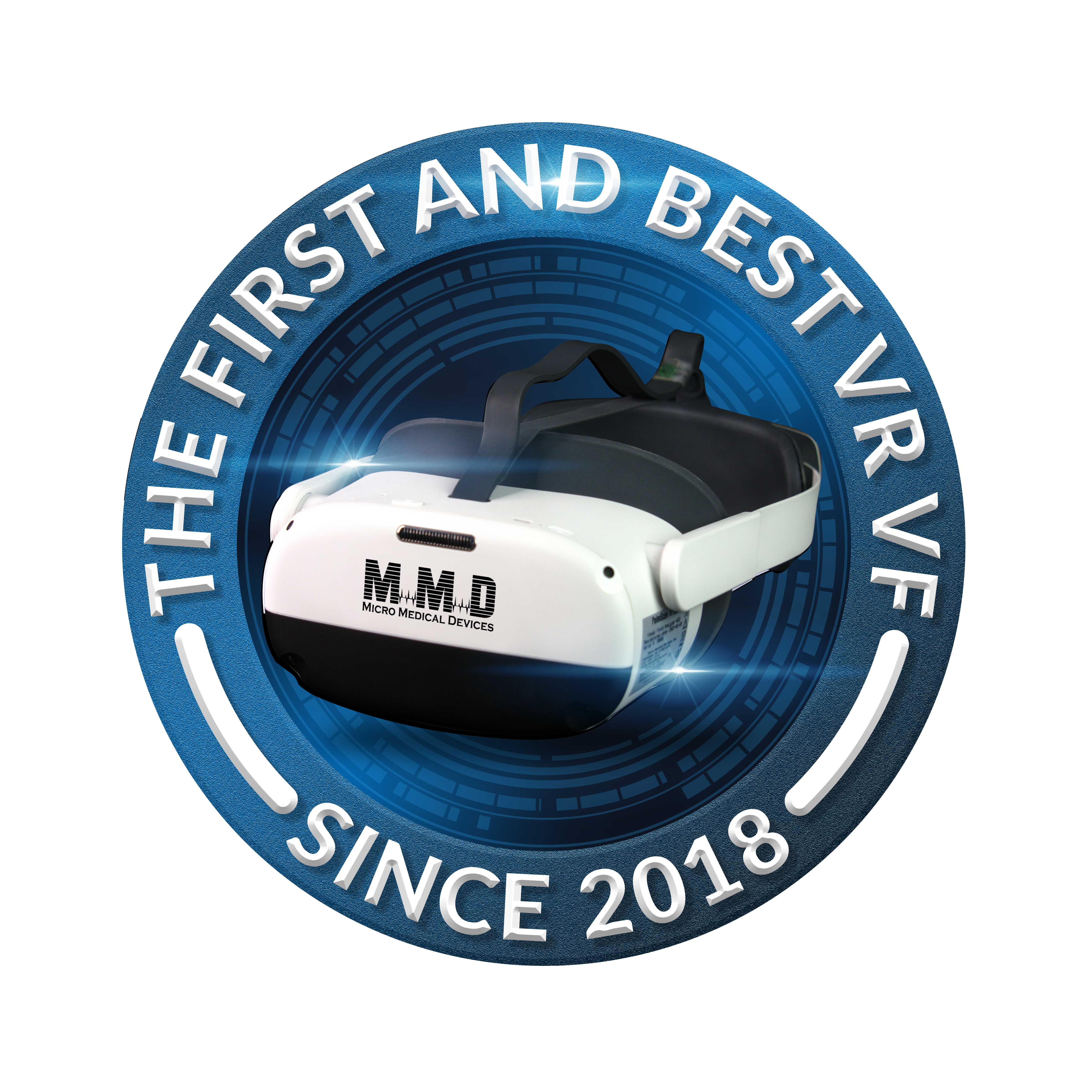Depth perception — or the ability to judge spatial distance — is one of the most remarkable functions of the human visual system. It allows us to perceive the three-dimensional world, coordinate eye movements, and interact with our environment safely and efficiently.
This function is made possible by stereopsis, the brain’s process of merging slightly different images from each eye to create a single 3D perception. Testing stereopsis accurately is crucial for diagnosing binocular vision disorders, strabismus, amblyopia, and other conditions affecting fusion and depth judgment. With advances such as virtual reality visual field systems, and vision virtual reality depth testing, clinicians can now evaluate stereopsis with unprecedented precision.
1. What Is Stereopsis?
Stereopsis is the perception of depth created when the brain interprets small differences (disparities) between the images captured by each retina. These binocular disparities are integrated in the visual cortex to produce a 3D view of the world.
Healthy stereopsis requires:
- Proper ocular alignment
- Normal retinal correspondence
- Intact fusion mechanisms
- Clear optical media and balanced refraction
When any of these are disrupted — such as in strabismus or amblyopia — the patient’s depth perception may deteriorate or disappear entirely.
2. Why Accurate Stereopsis Testing Matters
Testing stereopsis isn’t just about confirming binocular function — it helps eye care professionals:
- Detect subtle binocular vision deficits in early childhood
- Monitor surgical and therapeutic outcomes (e.g., post-strabismus or CXL surgery)
- Evaluate visual function in neurological or post-traumatic cases
- Assess occupational visual requirements for pilots, drivers, or athletes
Modern tools like virtual reality perimetry and VR visual field systems can now measure depth cues dynamically, mimicking real-life conditions with exceptional precision.
3. Traditional Techniques for Depth Perception Testing
Before digital advancements, clinicians relied on static, printed stereotests. These remain valuable for screening but may lack precision for clinical monitoring.
Common Stereopsis Tests Include:
- Titmus Fly Test – Large disparity for coarse stereopsis.
- Randot Stereo Test – Polarized targets for fine depth discrimination.
- TNO Test – Red-green anaglyph plates used under filtered glasses.
- Lang Stereotest – Random-dot patterns used without special eyewear.
While these tests are quick and accessible, their accuracy can vary based on lighting, patient cooperation, and environmental factors.
4. Modern Innovations: Virtual Reality Testing for Stereopsis
The emergence of virtual reality visual field and vision virtual reality systems has revolutionized depth perception testing. Using immersive 3D environments, virtual field and VR perimetry technologies allow practitioners to simulate real-world depth cues and dynamically assess fusion accuracy.
Benefits of Virtual Reality Perimetry in Stereopsis Testing:
- Controlled Disparity Presentation: Adjusts image separation precisely in real time.
- Immersive Environment: Patients experience realistic 3D depth tasks.
- Objective Measurement: Tracks fixation and eye movement using built-in sensors.
- Portable and Efficient: Conducted anywhere — no darkroom or specialized lighting needed.
💡 Virtual perimetry provides not only visual field data but also functional stereopsis evaluation — offering a holistic understanding of binocular performance.
5. Complementary Diagnostic Tools for Accurate Assessment
Accurate stereopsis evaluation benefits from integration with structural and optical diagnostics. By combining virtual visual field testing with tools like biometry, A-Scan, and B-Scan, clinicians can correlate depth deficits with anatomical findings.
| Diagnostic Tool | Purpose in Stereopsis Evaluation |
| Biometry / A-Scan (Ascan) | Measures ocular length asymmetry affecting binocular focus and fusion. |
| B-Scan (Bscan) | Detects orbital or retinal pathologies impacting binocular alignment. |
| Keratometer | Assesses corneal curvature differences that influence binocular alignment. |
| Pachymeter / Pachymetry | Monitors corneal thickness, crucial for surgical planning and refractive balance. |
| CXL (Corneal Crosslinking) or Corneal Cross-linking | Stabilizes corneal shape in keratoconus, maintaining consistent binocular geometry. |
By pairing functional tests (like virtual perimetry) with structural imaging, clinicians ensure a comprehensive approach to diagnosing and managing binocular vision disorders.
6. Pediatric Stereopsis Assessment
Early detection of depth perception deficits is critical for preventing amblyopia and promoting binocular development.
Virtual reality perimetry is especially effective for children, offering an engaging, game-like experience that improves compliance and accuracy.
Pediatric-focused features include:
- Interactive fixation targets
- Reduced testing time
- Real-time feedback for both child and examiner
💬 Pro Tip: Use vision virtual reality testing alongside standard stereotests to confirm both coarse and fine stereopsis levels in children aged 3 and older.
7. Post-Surgical and Rehabilitative Applications
After procedures like strabismus correction or CXL (Corneal Cross-linking), depth perception testing helps evaluate the restoration of binocular vision.
Virtual field platforms can quantify improvements in fusion range and stereopsis recovery. Combining this data with Pachymetry, A-Scan, and B-Scan results provides an evidence-based view of visual rehabilitation outcomes.
8. Ensuring Clinical Accuracy in Stereopsis Testing
To achieve consistent, high-accuracy results:
- Control Lighting and Viewing Conditions: Ensure uniform illumination for traditional tests.
- Maintain Proper Refractive Correction: Use trial lenses or phoropters during testing.
- Incorporate Technology: Adopt VR visual field or virtual reality perimetry for reproducible, digital accuracy.
- Document Results Systematically: Record stereoacuity thresholds (in arcseconds) and track progression over time.
Correlate Function with Structure: Always interpret stereopsis findings alongside biometry, B-Scan, and Pachymetry data.
9. The Future of Depth Perception Testing
With the integration of AI, machine learning, and vision virtual reality, the next generation of stereopsis assessments will feature:
- Automated disparity mapping
- Real-time fusion feedback
- Cross-platform tele-optometry compatibility
- Predictive analytics for early amblyopia or binocular dysfunction detection
These innovations position virtual reality perimetry as a central component of the future functional testing ecosystem — bridging the gap between structural imaging and visual performance analysis.
Conclusion
Stereopsis is the foundation of depth perception and a critical marker of binocular visual health. Accurate testing — through both traditional methods and modern innovations like virtual visual field and VR perimetry — enables clinicians to detect deficits early, guide therapy, and evaluate recovery with confidence.
By combining virtual reality visual field systems with biometry, A-Scan, B-Scan, Pachymetry, and Corneal Crosslinking, eye care professionals can deliver the most precise, data-driven assessments of depth perception available today.In short, understanding and testing stereopsis isn’t just about measuring depth — it’s about seeing the full dimension of vision itself.







